 Royal Navy Broadside Ironclads built 1861–1868: HMS Minotaur, Northumberland, Agincourt.
Royal Navy Broadside Ironclads built 1861–1868: HMS Minotaur, Northumberland, Agincourt.
The Minotaur-class ironclads were three armoured frigates of the Royal Navy, designed as enlarged versions of HMS Achilles with heavier armament, thicker armour, more powerful engines. They were formidable ships in size and armament, but were also unique for their rigging on five masts. They truly were the expression of Victorian battleships, their multiple masts made them appear even larger that they really were. The class comprised the HMS Minotaur (Thames Ironworks), HMS Agincourt (Laird, Son and Co. in Birkenhead) and HMS Northumberland (Milwall Iron Works, Millwall). Completed in 1867-68 they remained in service for many years. Their iron hull resisted well in the long run and they were used for other auxiliary roles, sometimes renamed, and discarded in 1922, 1935 and 1960.
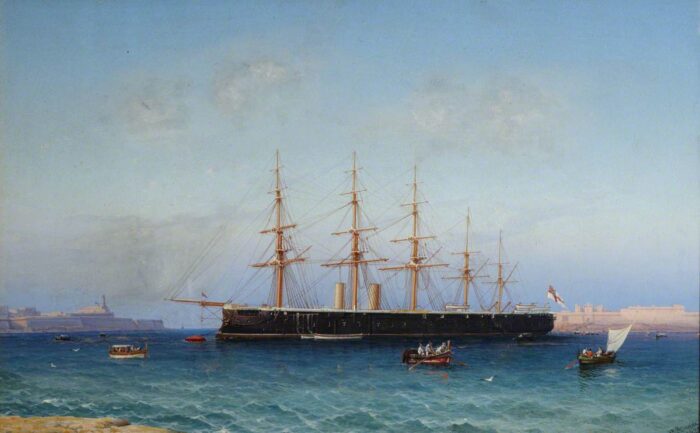
Design of the Minotaur class
The Minotaurs were a return to the Warrior class in terms of size, tonnage and armament. They were designed with a comparatively narrow hull with a ratio favourable to speed. The hull shape led to install five masts, in an attempt to decrease their size and make rigging management easier. At this stage were there capstans and other systems that were steam-driven.
These ironclads of course integrated a ram bow, quite a difference from the clipper-style bows of the Warriors, but plough-shaped and more prominent than that of Achilles. The armour reflected changes made since 1860 also: Their sides were fully armoured, to protect their intended 50 guns. The ships were originally planned indeed to mount forty Armstrong 110-pounder breech-loading guns, all on the main deck, and an extra ten more on pivot mountings, on the upper deck. However in service, these guns failed completely leading to a re-evaluation and thus, delays to find the most relevant armament.
The ships were finally armed with 9-inch muzzle-loading rifles (MLR), all on metal carriages, plus 7-inch MLRs on rope-worked carriages. However they were were mounted relatively low over the water. In a moderate swell these 7-inch guns were so washed over by seaspray they ended unworkable, so this was not overall a success. However by the sheer size and general appearance they sured played their role as a naval deterrence.
The three Minotaur class were built at different yards, HMS Minotaur was ordered to Thames Ironworks and Shipbuilding Co. HMS Agincourt was laid dow at Laird, Son and Co. of Birkenhead. Then, HMS Northumberland was ordered from Milwall Iron Works in Millwall.
Hull and general design


Brasseys profiles: Agincourt (top), Northumberland (bottom).
The Minotaur class were the largest broadside ironclads of the world as completed, with a symbolic 400 feet (121.9 m) long between perpendiculars, something unheard of for a hull, 411 feet (125.3 m) long overall. They had a beam of 58 feet 6 inches (17.8 m) making for a hull ratio making them fast on paper, but with a poor agility. They had a draft of 26 feet 10 inches (8.2 m) and displaced 10,627 long tons (10,798 t). The tonnage was as designed, not fully loaded, as it was not the norm yet to separate standard and fully loaded displacement figures. Their hull was subdivided into 15 watertight transverse bulkheads, in addition to a double bottom underneath the engine, as well as under their boiler rooms.
Powerplant
Under Steam
The Minotaur class also held a record as having the most powerful powerplants so far. This consisted in a single two-cylinder trunk steam engine manufactured by John Penn and Sons, their largest on record, driving a classic single 24-foot (7.3 m) four-bladed (presumably) propellers. This engine was fed steam from ten rectangular fire-tube boilers, at a working pressure of 25 psi (172 kPa; 2 kgf/cm2). This provided a total of 6,949 indicated horsepower (5,182 kW) during sea trials, on 10 May 1867. Minotaur made a run at 14.33 knots (26.54 km/h; 16.49 mph), making her builders satisfied, as the contracted speed was 14 knots (26 km/h; 16 mph). Note that all three ships diverged in power and Agincourt was different as her machinery, a 2-cylinder HSE, used double piston rods instead. Respectively the output for the latter was 6,867 shp, and 6,558 for Northumberland.
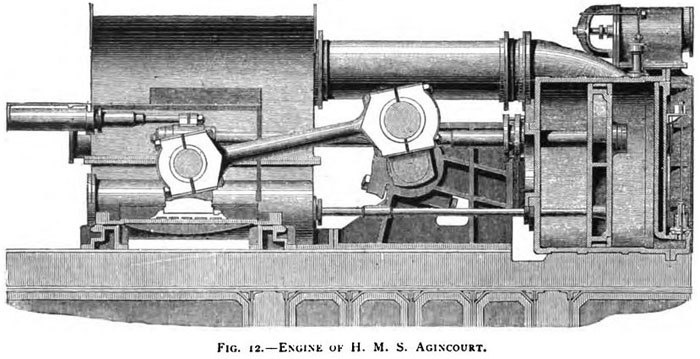

HMS Agincourt’s trunk engine
The Minotaur class carried also 750 long tons (760 t) of coal which enabled them to steam 1,500 nmi (2,800 km; 1,700 mi) at 7.5 knots (13.9 km/h; 8.6 mph) or for other sources, 1200 nautical miles at 10 knots. Minotaur was reboilered in 1893 and managed to maintain 14 knots (26 km/h; 16 mph) from 6,288 ihp (4,689 kW). They also diverged in speed, as Minotaut had her best speed of 14.4 knots, Agincourt performed the best as 15.4 knots and Northumberland had issues reaching just 14.1 knots as her best trials speed.
Under Sail
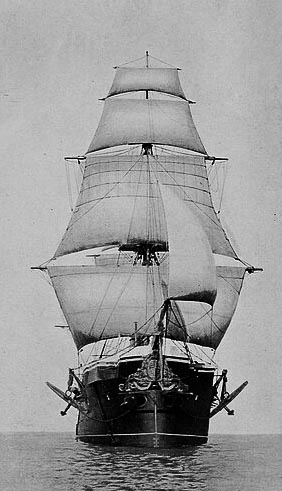 Minotaur was completed in 1865 but spent 18 months testing experimental armaments and rigs before being commissionned, starting with a square rig on her first four masts, spanker on the 5th. I was judged mediocre so the yards were removed from the 4th mast. This final rig was adopted for her sisters. Northumberland differed by having a gaff on all masts, the other two ships had no gaff on the 2nd mast.
Minotaur was completed in 1865 but spent 18 months testing experimental armaments and rigs before being commissionned, starting with a square rig on her first four masts, spanker on the 5th. I was judged mediocre so the yards were removed from the 4th mast. This final rig was adopted for her sisters. Northumberland differed by having a gaff on all masts, the other two ships had no gaff on the 2nd mast.
As far as their agility at sea under sails, they were noted as poor sailors, never exceeding 9.5 knots (17.6 km/h; 10.9 mph) under sail, with all sail up and favourable wings and calm seas. And this was despite of the number of masts they exhibited, a unique case of having a fore-, second-, main-, fourth- and mizzen- mast. This represented a total of 32,377 square feet (3,008 m2). Other sources gives 3010 m2. However they had extra drag as the propeller could not be disconnected and lifted, hoisted up as in other ironclads into the stern. However, they all had semi-retractable funnels.
Admiral George A. Ballard described Minotaur and her sisters as:
“the dullest performers under canvas of the whole masted fleet of their day, and no ships ever carried so much dress to so little purpose.”
In 1893–4, after her withdrawal from active service she had two masts removed and was re-rigged as a barque as her sisters. The masts were a bit taller but she performed better under sail.
They ended as the most sluggish of all British ironclads while under sail, particularly when compared to the elegant Warrior class.
They were regarded under steam however as good sea-boats and considered among the steadiest ships in the fleet, good, stable gunnery platforms with a gentle and predictable roll. They were however, as expected for their hull ratio, slow in manoeuvre under hand-steering, they bled speed when pushed hard rudder as well. But after a while steam steering was fitted and they performed much better. Northumberland was the first so fitted, her sister followed in their 1870s update.

Protection
The Minotaur class were a bit radical in their armour scheme. Their entire side was protected by wrought iron armour, tapered from 4.5 inches (114 mm) at the ends, up to 5.5 inches (140 mm) amidships. There was however a section of the bow between the upper and main decks that was left unprotected. This belt armour extended 5 feet 9 inches (1.8 m) below the waterline. The belt was backed by 10 inches (254 mm) of teak as it was customary to buffer the shell impact. They had of course a bulkhead, a sngle one to protect the battery against raking fire, 5.5-inch thick which protected the forward chase guns on the upper deck. They lacked a conning tower unlike French ironclad though, apart Northumberland. The latter was the only one fitted with one. Its walls were 114 mm thick (4.5 inches). She was also the only one with a restrictive belt along 56.3 m (183 ft) and two bulkheads (same thickness) instead of one for a full citadel. This was explained by her reduce battery with heavier guns compared to the others.
Armament
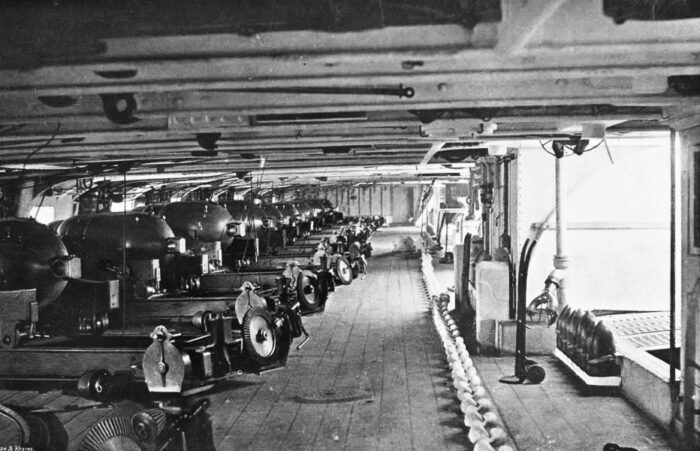
The Minotaur-class armament was at first, when designed in 1861, a total of 50 rifled 110-pounder breech-loading guns, with 40 in the main battery and imited arc, and 10 on the upper deck, on pivot mounts for extra traverse. The gun was taunted by Armstrong as a revolution to the admirakty, but ended a failure in operation, leading to a quick revision of armament whereas the ships were already close to completion. The intended gun was withdrawn and instead, they ended with a mix of twenty 7-inch (178 mm) and four 9-inch (229 mm) rifled muzzle-loading guns.
The four 9-inch and all 20 twenty 7-inch guns were mounted on the main deck. Four 7-inch guns were fitted on the upper deck, as chase guns. In addition, they had eight brass howitzers used as saluting guns, and potentially for a landing party. Their hull had gun ports 30 inches (0.8 m) wide allowing in the main battery a 30° traverse either side.
Again, Northumberland differed from the pack by having twenty-two 8-in(203mm)/15 MLR Mk III, and two 7 in(178mm)/16 MLR Mk III.
9-inch guns Armstrong
This model made by Arsmtrong was also used by Spain and the Netherlands. Specifications as follows:
Gun weight 12 long tons (12.3 t) for 3.962 m long.
Shell: 14-calibre 9-inch (229 mm), 254 pounds (115.2 kg)
Muzzle velocity: 1,420 ft/s (430 m/s)
Penetration: 11.3 inches (287 mm) of wrought iron armour at the muzzle.
Range unknown, c4000 yards.
7-inch guns Armstrong
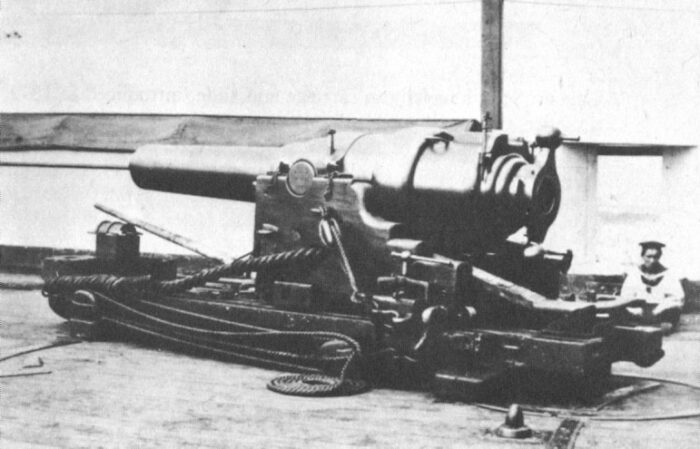
The 16-calibre 7-inch gun (177.8 mm) weighed 6.5 long tons (6.6 t) for 99.5 inches (2.527 m) bore (14.21 calibres) long.
It fired a shell 90 to 109 pounds (40 to 50 kg) using an Armstrong screw with vertical sliding vent-piece (block).
The average was a 112-pound (50.8 kg) shell.
It was capable of 1,100 feet per second (340 m/s) and a max range of 3,500 yards (3,200 m), credited with the ability to penetrate 7.7-inch (196 mm) armour.
Refits
1873-75: Minotaur was reboilered, with a new propeller and new stem steering; for 6288 shp and 14.1 kts speed. She was rearmed with only seventeen 6-inch guns, fourteen on the main deck, two forward as chase guns, one aft as chase gun. Gun ports were further enlarged to accommodate larger guns. It was done by hand at a cost of £250 each.
1875-77: Agincourt received the same upgrade as her sister Minotaur
1875-79: Northumberland was the first loosing her 2nd and 4th masts, re-rigged as a barque. She was rearmed a different way, with seven single 9-inches (229mm)/14 MLR Mk IV, and twenty 8-in(203mm)/15 MLR Mk III, as well as two 4-in(95mm)/21 20pdr 16cwt BL, and four 14-in or 356mm Torpedo Tubes.
1883: Minotaur and Agincourt: Two 6 inches (152 mm) breech-loading guns replaced two 9-inch MLRs.
1885-87: Northumberland lost two 8-in/15 but gained a 6-in(152ll)/26 BL Mk III/IV/VI and a single 5-in(127mm)/25 BL Mk I/II/III/IV/V.
1892: Minotaur, Agincourt: Four QF 4.7-inch (120-mm) guns, eight QF 3-pdr Hotchkiss, eight 0.45 in(11.4mm)/87 machine guns, two torpedo tubes installed.
1893: Northumberland: She saw the addition of six 4.7 in QF/40 Mk I/II/III/IV, tent 3-pdr or 47mm/40 Hotchkiss QF Mk I, and six 11.4mm/87 Vickers MGs but no TTs.
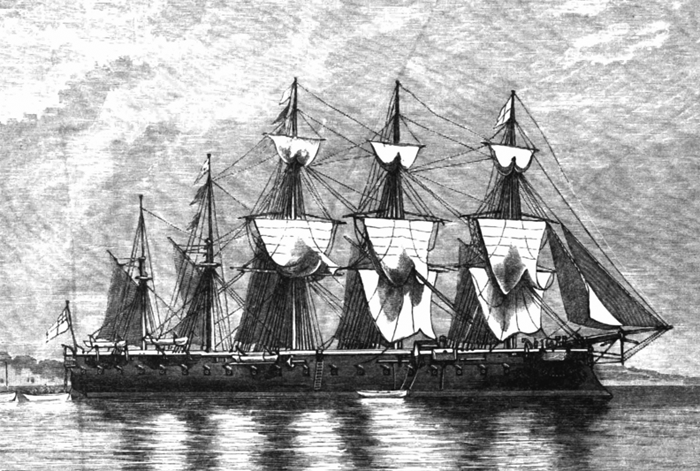
⚙ Minotaur class specifications |
|
| Displacement | 10,627 long tons (10,798 t) |
| Dimensions | 407 ft x 59 ft 6 in x 27 ft 9 in (124.05 x 18.1 x 8.5 m) |
| Propulsion | 1 shaft, 1 trunk steam engine, 10 fire-tube boilers: 6,949 ihp (5,182 kW) |
| Sail plan | 5 masted |
| Speed | 14 knots (26 km/h; 16 mph) |
| Range | 1,500 nmi (2,800 km; 1,700 mi) at 7.5 knots (13.9 km/h; 8.6 mph) |
| Armament | 4 × 9-inch (229 mm) RML, 24 × 7-inch (178 mm) RMLs |
| Protection | Belt 4.5–5.5 in (114–140 mm), Bulkheads: 5.5 in (140 mm) |
| Crew | 800 actual |
Career of the Minotaur class
 HMS Minotaur (ex-Elephant) (1863)
HMS Minotaur (ex-Elephant) (1863)
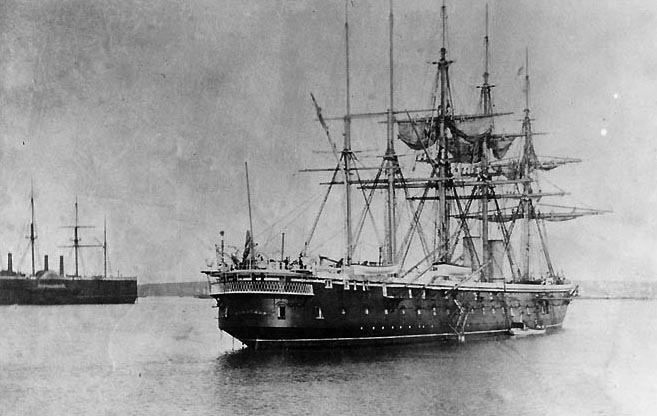
HMS Minotaur was ordered on 2 September 1861 as HMS Elephant (Nelson’s flagship 70 years before) but changed during construction. She was laid down on 12 September 1861 at the Thames Ironworks in Blackwall, London and launched on 12 December 1863, to be commissioned in April 1867, completed on 1 June 1867. Her completion was delayed due to frequent changes in design details, notably her armament and rigging for a total cost of £478,855.
Minotaur had her final commission in Portsmouth as flagship, Channel Squadron, until 1873. In 1872 she nearly was rammed by HMS Bellerophon when leaving Belfast Lough via a narrow waterway. Minotaur lost her bowsprit and fore topgallant mast and Bellerophon suffered some minor flooding. Minotaur was then paid off for a long refit in 1873 until 1875, bacl to the Channel Squadron. She was the first ship in the Royal Navy to receive a permanent electric searchlight in 1876.
In 1882, she was part of naval operations off Egypt as the British invasion took place. She arrived at Alexandria just after the British squadron had silenced the port’s defences, on 11 July. She remained there, shelling more shore positions until October 1882 and sailed for Malta. On 24 December 1886, she collided with HMS Monarch in the Tagus, the latter was far more damaged.
On 28 February 1887, she rescued passengers and crew of steamship Valparaiso, wrecked on a reef off Vigo. She became flagship of Vice Admiral Sir William Hewett (Victoria Cross for the siege of Sevastopol) at the Queen’s Golden Jubilee Fleet Review, 23 July 1887. Minotaur was paid off by late 1887 in Portsmouth, assigned to the Reserve until 1893. She became a training ship at Portland, renamed HMS Boscawen II by March 1904. In 1905 she was attached at the Harwich training school, est. HMS Ganges. On 11 June 1906 she became HMS Ganges. On 25 April 1908, Ganges II. She was ultimately sold on 30 January 1922 and BU, the first in her class.
 HMS Agincourt (ex-Captain) (1865)
HMS Agincourt (ex-Captain) (1865)
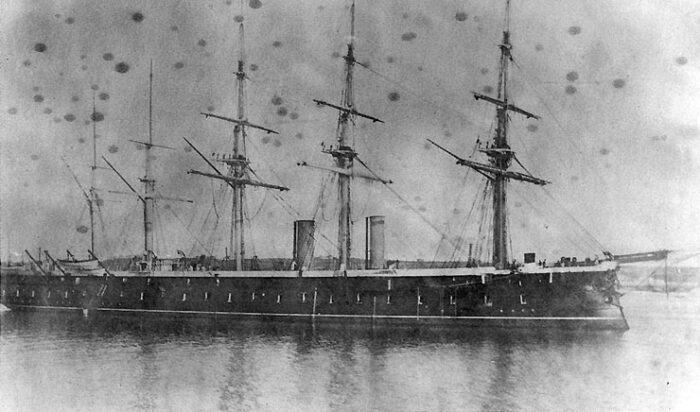
HMS Agincourt (named after the Battle of Agincourt victory, 1415) was originally ordered on 2 September 1861 as HMS Captain. Her name was changed during construction and she was laid down on 30 October 1861 at Laird, Birkenhead, launched on 27 March 1865, commissioned in June 1868 in time for sea trials, completed on 19 December. Like her sister she especiernces changes in armament and rigging. Total cost was £483,003.
Her first assignment with Northumberland, towing a floating drydock to Madeira, then by Warrior and Black Prince to Bermuda. She departed on 23 June 1869 with an extra 500 long tons (510 t) of coal stowed in bags on her decks. The towing trip took 11 days. She was assigned to the Channel Squadron, became flagship, 2nd-in-command until her refit in 1873.
She ran aground on Pearl Rock near Gibraltar on 1 July 1871. This was quite serious, as she nearly sank while leading the inshore column contrary to normal practice (the senior flagship usually led the inshore column). She ran aground sideways when the navigator failed to compensate for the set of the tide. Warrior nearly collided with her but sheered off in time.
Agincourt had to be lightened, guns and coal removed and she was towed off by HMS Hercules (Lord Gilford) 4 days afterwards. She was lucky as Heavy weather went on the next night. She could have been wrecked if not. Later the fleet commander and deputy were relieved of command. She was repaired in Devonport for £1,195. Captain J.O. Hopkins which took command in September commented he entered a ship that was the “noisiest and worst disciplined ship in the squadron”. In the Mediterranean she hosted the Lord Clyde court-martial, and performed well in drills and exercises.
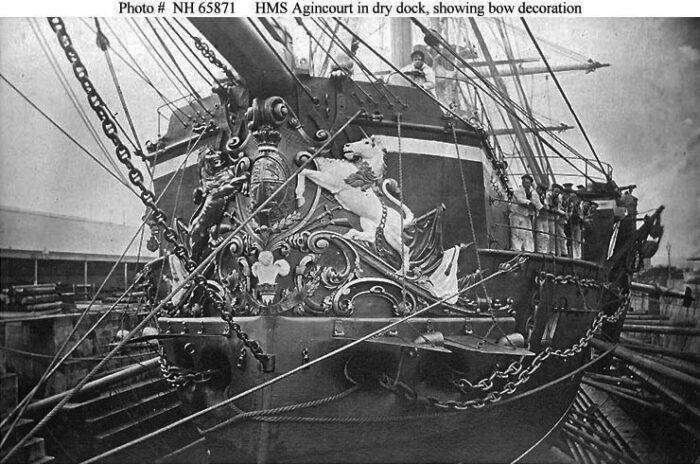
In 1873, Vice Admiral Sir Geoffrey Hornby (Channel Squadron) transferred his flag to Agincourt as Minotaur was in refit until 1875. She would be herself was paid off in turn for a refit until 1877. As the Russo-Turkish War of 1877–78 took place, the British government became concerned about the fall of the Constantinople. Hornby was ordered to create the “Particular Service Squadron” to show the flag at Constantinople, deterring the Russians. Agincourt was flagship, second-in-command when arriving off the Dardanelles in a snowstorm by February 1878. She was back in the Channel as second flag until 1889 and took part in Queen Victoria’s Golden Jubilee Fleet Review, in 1887. For her whole career she remained flagship for 15 admirals until paid off, held in reserve at Portsmouth until 1893, then transferred to Portland as training ship.
She spent 12 years at Portland as depot ship for boys, as Boscawen III from March, 1904. In 1905 in Harwich she was known as Ganges II and in 1909, was towed to Sheerness, then converted into coal hulk “C.109”. She became what Oscar Parkes described as a “grimy, dilapidated and incredibly shrunken relic” until scrapped from 21 October 1960.
 HMS Northumberland (1866)
HMS Northumberland (1866)
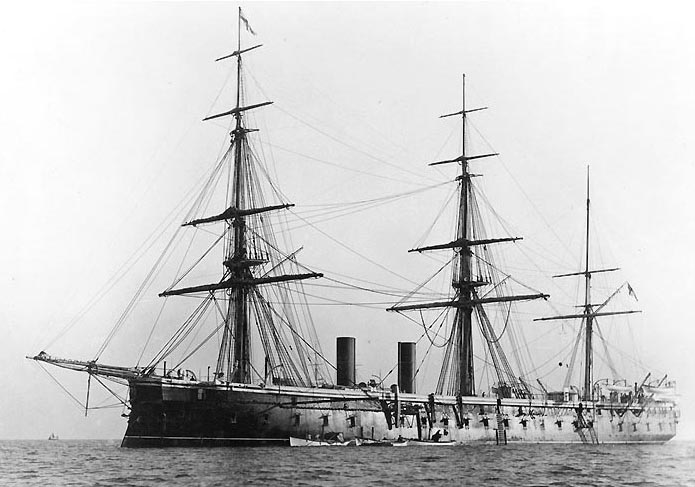
Northumberland (named after the ceremonial county) was ordered on 2 September 1861 frome Millwall Ironworks, laid down on 10 October 1861, altered while under construction as Sir Edward Reed replaced Isaac Watts as RN Chief Constructor. The five years she spent was due to many changes in design, and she gained additional weight. This cause her to stick for an hour on the slipway when attempted to launch. And then she only managed to slid halfway down, her stern only supported by air. Hydraulic jacks and tugboats failed even with the next spring tide but succeeded on 17 April 1866 when using pontoons. Her builders went into bankruptcy. The liquidators seized her as a company asset, only whe she was afloat and eight months went on passed until the Admiralty took possession of her for fitting out. She was commissioned in October 1868, completed on 8 October at a cost of £444,256.
Her first posting was to the Channel Squadron until 1873. Roderick Dew wanteds to paint all her yards black to make a difference from her half-sisters (white yards). She assisted Agincourt towing a floating drydock to Madeira (see abive). While anchored at Funchal, Madeira, on 25 December 1872, a gale made her parting her anchor chain. She drifted onto the ram bow Hercules, her flank seriously damaged below the waterline, a compartment flooded. She managed to sail to Malta for repairs.
She became flagship, second-in-command until Minotaur was back from refit, and became flagship for Rear Admirals George Hancock and Lord John Hay before undergoing herself a refit and rearmament from 1875 to 1879. She was back with the Channel Squadron and paid off in 1885. She had another refit, became flagship for Vice Admirals Sir William Hewett and John Baird from 1887. Assigned to the 1st Reserve Squadron, Portland in 1890–91 she was transferred to Devonport 1891-1898, hulked that year as as a stokers’ training ship. She was anchored at the Nore as HMS Acheron from 1 January 1904. She was decommissioned on 31 March 1910, and transferred from the Chatham Naval Barracks to be the “C.8” coal hulk at Invergordon, then “C.68” in 1926. She was sold in 1927, resold, renamed “Stedmound” and sent in Dakar until scrapped in 1935.
Read More/Src
Books
Coward, B. R.: Battleships & Battlecruisers of the Royal Navy since 1861. Runnymede, Englanti: Ian Allan Ltd, 1986.
Gardiner, Robert (toim.): Conway’s All the World’s Fighting Ships 1860-1905. Conway Maritime Press, 2002.
Winfield, Rif: British Warships in the Age of Sail 1817-1863 – Design, Construction, Careers and Fates. Seaforth Publishing 2014.
Ballard, G. A., Admiral (1980). The Black Battlefleet. Annapolis, Maryland: Naval Institute Press. ISBN 0-87021-924-3.
Brown, David K. (2003). Warrior to Dreadnought: Warship Development 1860–1905 (reprint of the 1997 ed.). London: Caxton Editions.
Friedman, Norman (2018). British Battleships of the Victorian Era. Annapolis, Maryland: Naval Institute Press.
Parkes, Oscar (1990) [1957]. British Battleships. Annapolis, Maryland: Naval Institute Press.
Silverstone, Paul H. (1984). Directory of the World’s Capital Ships. New York: Hippocrene Books.
Text Book of Gunnery. London: Harrison and Sons for His Majesty’s Stationery Office. 1887.
Gallery
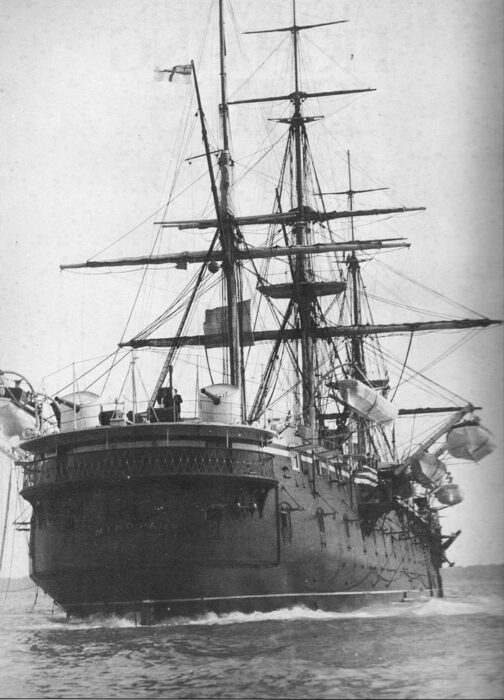
Links
https://www.navypedia.org/ships/uk/brit_bb1_minotaur.html
https://commons.wikimedia.org/wiki/Category:Minotaur_class_battleship
Model Kits
None found


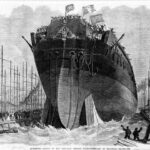
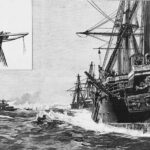



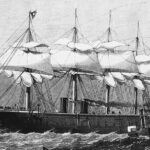




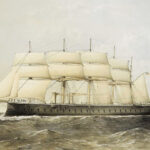
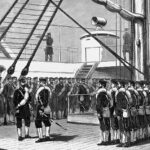
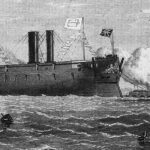
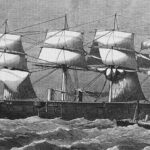
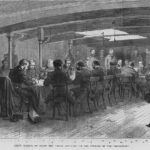
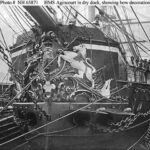
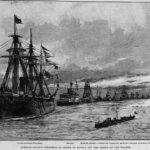
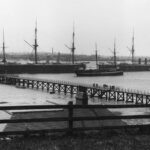
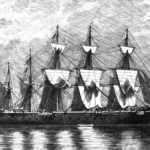


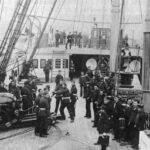
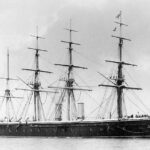
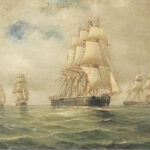
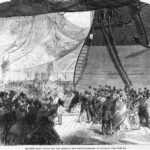
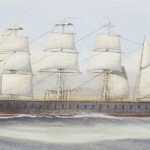
 Latest Facebook Entry -
Latest Facebook Entry -  X(Tweeter) Naval Encyclopedia's deck archive
X(Tweeter) Naval Encyclopedia's deck archive Instagram (@navalencyc)
Instagram (@navalencyc)



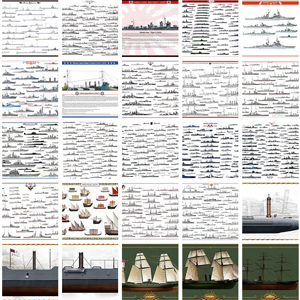

 French Navy
French Navy Royal Navy
Royal Navy Russian Navy
Russian Navy Armada Espanola
Armada Espanola Austrian Navy
Austrian Navy K.u.K. Kriegsmarine
K.u.K. Kriegsmarine Dansk Marine
Dansk Marine Nautiko Hellenon
Nautiko Hellenon Koninklije Marine 1870
Koninklije Marine 1870 Marinha do Brasil
Marinha do Brasil Osmanlı Donanması
Osmanlı Donanması Marina Do Peru
Marina Do Peru Marinha do Portugal
Marinha do Portugal Regia Marina 1870
Regia Marina 1870 Nihhon Kaigun 1870
Nihhon Kaigun 1870 Preußische Marine 1870
Preußische Marine 1870 Russkiy Flot 1870
Russkiy Flot 1870 Svenska marinen
Svenska marinen Søværnet
Søværnet Union Navy
Union Navy Confederate Navy
Confederate Navy Armada de Argentina
Armada de Argentina Imperial Chinese Navy
Imperial Chinese Navy Marinha do Portugal
Marinha do Portugal Mexico
Mexico Kaiserliche Marine
Kaiserliche Marine 1898 US Navy
1898 US Navy Sovietskiy Flot
Sovietskiy Flot Royal Canadian Navy
Royal Canadian Navy Royal Australian Navy
Royal Australian Navy RNZN Fleet
RNZN Fleet Chinese Navy 1937
Chinese Navy 1937 Kriegsmarine
Kriegsmarine Chilean Navy
Chilean Navy Danish Navy
Danish Navy Finnish Navy
Finnish Navy Hellenic Navy
Hellenic Navy Polish Navy
Polish Navy Romanian Navy
Romanian Navy Turkish Navy
Turkish Navy Royal Yugoslav Navy
Royal Yugoslav Navy Royal Thai Navy
Royal Thai Navy Minor Navies
Minor Navies Albania
Albania Austria
Austria Belgium
Belgium Columbia
Columbia Costa Rica
Costa Rica Cuba
Cuba Czechoslovakia
Czechoslovakia Dominican Republic
Dominican Republic Haiti
Haiti Hungary
Hungary Honduras
Honduras Estonia
Estonia Iceland
Iceland Eire
Eire Equador
Equador Iran
Iran Iraq
Iraq Latvia
Latvia Liberia
Liberia Lithuania
Lithuania Mandchukuo
Mandchukuo Morocco
Morocco Nicaragua
Nicaragua Persia
Persia San Salvador
San Salvador Sarawak
Sarawak Uruguay
Uruguay Venezuela
Venezuela Zanzibar
Zanzibar Warsaw Pact Navies
Warsaw Pact Navies Bulgaria
Bulgaria Hungary
Hungary

 Bundesmarine
Bundesmarine Dutch Navy
Dutch Navy Hellenic Navy
Hellenic Navy Marina Militare
Marina Militare Yugoslav Navy
Yugoslav Navy Chinese Navy
Chinese Navy Indian Navy
Indian Navy Indonesian Navy
Indonesian Navy JMSDF
JMSDF North Korean Navy
North Korean Navy Pakistani Navy
Pakistani Navy Philippines Navy
Philippines Navy ROKN
ROKN Rep. of Singapore Navy
Rep. of Singapore Navy Taiwanese Navy
Taiwanese Navy IDF Navy
IDF Navy Saudi Navy
Saudi Navy Royal New Zealand Navy
Royal New Zealand Navy Egyptian Navy
Egyptian Navy South African Navy
South African Navy






























 Ukrainian Navy
Ukrainian Navy dbodesign
dbodesign